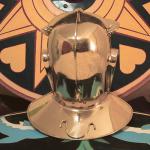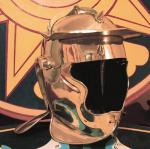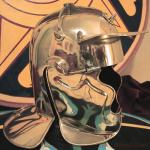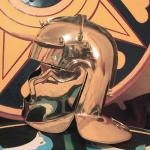Casque Type Niederbieber
English Translation
Merci à Armae pour son autorisation pour les photographies
Historique Voir ICI
History Click HERE
Le Casque romain type Niederbieber (également Rainau-Buch/Niederbieber) était une casque des légions et les troupes auxiliaires.Son nom provient du Fort de Niederbieber située sur le Limes supérieur de Germlarnie detruit en 260. Les Casques de ce type sont considérées comme le dernier avatar du type Imperial gaulois Le modèle Niederbieber fut utilisé de la fin du 2e au 3e siècle
Description
Le Casque Niederbieber est en tole ou bronze il sont haut avec un couvre nuque allongé vers le bas.Il est tres important et il se courbe presque à angle droit . La calotte fabriquée en 2 parties est renforcée par une crèete en forme de croix qui regidifi l'ensemble et fait devier les coups vendant du dessus. les parejoues sont tres volumineux Les oreilles sont degagées mais en meême temps protégées . Ils sont reliées entre eux via une laniere ne cuir . ; Il y a 3x troux pour la fixation ce qui est une caractéristique typique de tous les casques Weisenau
Ce système de fixation empeche le casque de glisser ou de se deplacer.
Ce type de casque est considéré comme rare Certains le voit comme un casque de cavalaier comme H. Russell Robinson d'autres comme Marcus Junkelmann le classe comme casque d'infanterie . Aujourd'hui, il est admis que le casque a servit dans les 2 corps
Les casques tyepe Rainau-boch- Niedermörmter et Niederbieber appartiennent au dernier developpement du typeWeisenau. Les casque type Niederbieber se caractérisent par un renforcement de la protection de la zone du menton joue et ilo est apparu à la fin du 2ème siècle
La production
Depuis la découverte de ce type de casque Niederbieber en bonze dans un puits du fort de Neiderbeiber l'etude de cette forme de casque a avancé Ce casque de bronze est incomplet car il manque les pare- joues
 |
 |
The Roman helmet type Niederbieber (also Rainau-Buch/Niederbieber ) was a protective weapon of legions and auxiliary troops. Name derives from the locality was of n 260. Chr. Destroyed fort Niederbieber the Upper Germanic Limes. Helmets of this type are considered as the latest form of the typical kaiser time-Gallic helmet type Weisenau which is palpable from the late Republican period in the find material. The type Niederbieber was in the late 2nd and 3rd centuries in use. During the late antiquity then found completely new helmet forms the entrance to the Roman military system.
Description
Helmets type Niederbieber consist of sheet bronze and possess a relatively flat piece with a extremely pulled down nape. The subsequent wide neck guard is bent projecting flat and back down. On the dome there is a manufactured from two metal sheets cross-strap, which makes as a reinforcing protection of the helmet slide one fell swoop from above. The temple, which extends over the apex line starts at the forehead and ends in the neck area. He is attached to the front and rear ends, each with a large cone-shaped bronze rivets. Another smaller ridge runs from the right to the left side of the helmet and crossed at the apex of the other comb. The ends of the comb are soldered to the cap. The ear region is widely excised and the edges are roundish blunted, to protect the ears from injury. On the right and left wide cheek guards are mounted with the help of hinges. To fasten the helmet on the wearer's head, a leather strap was pushed by fastening rings under the neck guard and then guided forward crosswise through the eyelets at the bottom of the cheek, and finally tied. This three-point hitch was a typical feature of all Weisenau helmets and prevented that the helmet could be slippage or moved.
This type of helmet is considered quite rare find object and is scientifically assessed differently. During the Roman weapons experts H. Russell Robinson understood the Niederbieber as a rider helmet, looked at him Marcus Junkelmann as infantry helmet. Today however, most believed that the Niederbieber helmet also found the use of both cavalry in the infantry as. In addition to models from Rainau-Buch and also the type Niedermörmter Niederbieber belongs to the late models of Weisenau. The heavily armored helmets type Niederbieber with its strongly pronounced, in the chin area overlapping cheek emerged at the end of the 2nd century and were up to the introduction of the new late antique helmet shapes from the Spangenhelmen type Der-el-Medineh about 270 n. Chr. in the find material appeared worn.
Production
Since the discovery of a bronze helmet type Niederbieber which came apparently as a semi-finished product into a well of the camp village of Rainau book,.the research may have also gained over the course of a manufacturing process knowledge. This bronze
 |
helmet is missing several items that were in further steps need to be applied. Thus, the carrying handle on the wide, sloping neck guard, for already the two eyelets were installed, the crossed brass bracket on the dome and in the type Niederbieber very pronounced, flared and the end towards the middle tapering horizontal trim strip. The data necessary for the provision of these items holes in the dome were also not available yet.












